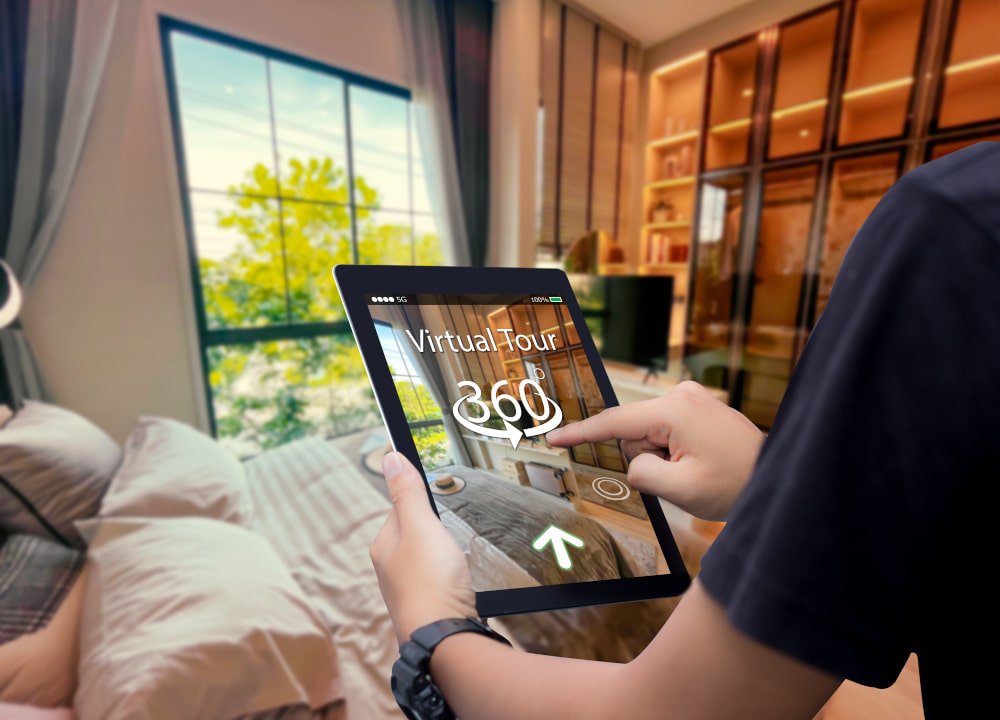How to Use Real Estate Virtual Tours When Buying a Home

Understanding today’s digital tools is one of the best ways to stay informed and confident when looking for a home in the current real estate market that is changing quickly. With the ability to view homes from any location, save time, and make better decisions before entering a property, virtual tours have swiftly emerged as a revolutionary tool.
This guide explores the benefits, tools, and best practices for using virtual tours in the real estate buying process. Learn how to use real estate virtual tours to streamline your home-buying process, and discover tips, tools, and more on how to get started.
What is a real estate virtual tour, and how does it work?
A real estate virtual tour is a digital simulation of a house or property that gives the viewer the opportunity to walk through a house online. Virtual tours tend to comprise the following:
- Panoramic views in 360 degrees, and you can look around every room
- Video tours show the viewer around the house
- Dynamic floor plans that include rooms that are clickable
- Models of 3D layout
These tours are usually recorded by special 360 cameras and processed by unique software, which helps them to join pictures together to create an environment of interaction with the property, despite not being there physically.
| Virtual Tour Type | Experience Level | Best For |
|---|---|---|
| 360 Degree Views | High realism | Depth and layout exploration |
| Video walkthrough | Guided experience | Quick first look |
| 3D Dollhouse Model | Most immersive | Evaluating space and structure |
Why are virtual tours becoming essential for today’s home buyers?
During the pandemic, virtual tours became popular as buyers and sellers got used to social distancing measures. Although face-to-face showings have come back, internet watching practices stayed in place since buyers realize they could save a great deal of time through virtual tours. Some benefits include:
- Saves time on traveling to homes that fail to meet the expectation
- Helps moving buyers tour houses that are not local
- Allows buyers to see a variety of options within a short time
“ Virtual home touring has quickly become a foundational first step in real estate, not just a convenience but an expectation.”
— Steven Crowe, Mortgage Agent Level 2 , Clover Mortgage
How do virtual house tours compare to in-person showings?
Virtual tours can be effective, yet there are benefits of an in-person showing, namely, because online tools cannot provide the same sensory experience as in-person viewing. Virtual tours are useful because they allow the buyer to determine the suitability of a property, and physical tours give them an actual feel of size and layout, natural lighting, surroundings, and craftsmanship.
| Category | Virtual Tour | In-Person |
|---|---|---|
| Convenience | Very high | Moderate |
| Sense of space | Strong | Most accurate |
| Detect issues | Limited | Strong |
| Time commitment | Low | Higher |
| Emotional feel | Moderate | Strong |
Can you really trust what you see in a virtual house tour?
Virtual tours provide a real perspective on space, although they do not necessarily take into account all the details. Some vendors can say they are showing the most favorable sides or a favorable light. To keep them updated, buyers are advised to combine virtual tours with agent-guided video calls and close-up follow-up requests of main locations such as kitchens, mechanical rooms, and basements.
Customers can request to have a live walkthrough, take more photos, and have inspection reports to ensure they see the actual state.
“ Virtual tours help buyers envision a bigger and more accurate picture of their ideal house or property. The details are verified by inspections and walkthroughs by the agents.”
— Victoria Ishai, Mortgage Agent Level 2 , Clover Mortgage
What are the most popular platforms and tools for creating real estate virtual tours?
The most popular platforms and tools for real estate virtual tours are Matterport , Zillow 3D , Kuula , and iStaging , which have various degrees of detail and different prices. The programs are in favor of panoramic photography, 3D modelling, and navigation that provides the buyers with a realistic and interactive feeling of walking around the house themselves.
| Platform | Best Feature |
|---|---|
| Matterport | Professional-grade 3D models |
| Zillow 3D | Instant MLS integration |
| Kuula | Affordable and user-friendly |
| iStaging | Mobile creation tools |
How to create a virtual tour for your property step-by-step
Before filming, sellers and agents make a home habitable by cleaning it to make the tour look clean, bright, and welcoming. To produce the video, rooms are staged, lights are set to their best, and wide-angle or 360 cameras are employed to implement the shots. The information is then uploaded into editing software, in which navigation points, labels, and floor plans are included. After publication, the tour is made available on the Internet, and it is attached to the listing.
Actionable Steps to Create a Virtual Tour:
- Clean and stage the home
- Stabilizer or Film with a 360 camera
- Upload onto the virtual tour software
- Include navigation and room heads
- Advertise the listing and social media
“ A good virtual tour is bright, smooth, and purposeful. Dictate visually, and not by simply by documenting rooms.”
— Steven Crowe, Mortgage Agent Level 2 , Clover Mortgage
What equipment do you need to build a high-quality virtual tour?
A 360-degree camera, a strong tripod, lighting equipment, and editing software like Matterport or iStaging are frequently used by real estate teams. A variety of sellers can use this technology because some tours can also be made with smartphones and a stabilizer.
Are virtual tours effective for spotting red flags in a property?
Surface-level problems such as awkward layouts, inadequate natural light, or antiquated finishes can be found with the help of virtual tours. They are not the best tools, though, for identifying neighborhood noise, water damage, or structural issues. As a result, buyers frequently use virtual tours as a preliminary screening tool and rely on home inspections and in-person visits to verify the condition.
“To determine which properties merit a visit in person, use virtual tours. Expert inspections play a key role.”
— Victoria Ishai, Mortgage Agent Level 2 , Clover Mortgage
How do real estate agents use virtual tours to attract more buyers?
Virtual tours are used by real estate agents to expand their reach and connect with more qualified leads. 3D-tour listings frequently have higher click-through rates and draw in serious buyers more quickly.
Additionally, virtual tours give buyers who are moving from other areas the confidence to explore markets from a distance. In order to increase appeal and spark interest, many agents now combine virtual home tours with professional staging and social media previews.
Should you rely only on virtual tours to make a purchase decision?
A very successful first step in the home-buying process is taking a virtual tour. Without having to travel to several showings, they let you compare homes, comprehend room flow, and rapidly narrow down your shortlist of potential properties. Before entering a property, buyers often say that virtual tours help them make more informed decisions.
To direct best practices, however, real estate and mortgage professionals place a strong emphasis on EEAT (Experience, Expertise, Authoritativeness, and Trustworthiness). Here’s how experts can apply EEAT to virtual tours:
| EEAT Principle | Professional Action |
|---|---|
| Experience | Share real home buyer usage and outcomes |
| Expertise | Explain where virtual viewing excels and fails |
| Authoratiativenes | Reference industry norms and inspection standards |
| Trustworthiness | Recommend verification steps and transparent guidance |
In summary, use virtual tours to efficiently identify top properties, then rely on an in-person visit and inspection to finalize a confident, informed purchase decision.
How can Clover Mortgage help you navigate the virtual buying process?
Clear financial advice and safe online procedures are necessary when purchasing a home virtually. Clover Mortgage offers buyers secure document submissions, fully online pre-approvals, and professional advisory consultations. Acting with confidence on properties found through virtual touring is made easier as a result.
In fact, there were 199,772 properties listed for sale on all Canadian MLS Systems according to CREA at the end of September 2025, up 7.5% from a year earlier but very close to the long-term average for that time of the year. With the abundance and increase of properties on virtual viewing systems, it’s imperative to identify the right professional support to guide you through the virtual buying process.
In adhering to the EEAT framework, Clover Mortgage professionals use their verified lending standards, licensed mortgage expertise, and lending experience to help buyers. This includes helping you evaluate affordability, compare mortgage options , and understand lender requirements, even if you are purchasing remotely or relocating from another province.
What are the future trends of virtual tours in real estate?
Virtual tours are also being developed as comprehensive digital solutions for home buying. Industry experts use the EEAT model in marketing by suggesting credible technology and mixing it with human expertise. In this manner, innovation is harnessed for buyers without diminishing transparency and expertise.
AI/VR integration , remote buying, and other immersive tools are expected to be the standard in the future. However, experts who effectively utilize the EEAT approach and leverage AI and other digital tools will find greater success in connecting with clients.
“ Technology such as AI-enhanced floor plans, virtual reality walk-throughs of homes, and home staging software is becoming more common in our business. It can be expected that such technology will continue to improve convenience for our clients, while at the same time proving that home inspections, guided tours, and analysis are a necessity.
— Victoria Ishai, Mortgage Agent Level 2 , Clover Mortgage
Should you consider virtual tours in your home-buying journey?
Virtual tours have become a crucial element of home buying in recent years, offering buyers convenience, efficiency, and valuable insight before ever setting foot in a house. While it is not a total replacement for in-house property visits, it offers a powerful first impression that allows buyers to remain well-informed and confident from the start of their house-hunting adventure.
Learning to integrate the use of virtual property tours with property inspection and trusted mortgage advice is important in making a secure purchase decision. Contact Clover Mortgage today to learn about how to best navigate the new digital age of virtual tours in the real estate market.
FAQ
Can I just rely on virtual tours to buy a home?
Although virtual tours are a great start, it is recommended that you choose a property that allows you to do a physical visit as well. You can use a virtual tour to choose a property and do a background check after that.
Are virtual tours accurate enough to evaluate a home's condition?
They accurately depict layouts, material finishes, and use of space, and will not necessarily indicate problems with structure, noise, or natural lighting at various hours of the day. It is recommended that such tours be supplemented with video walkthroughs or walk-through inspections.
Do virtual tours work for long-distance or relocation buyers?
Yes. In fact, relocation buyers often start completely online and fly in for inspections and final checks as soon as it’s possible to work out travel arrangements. Behind secure financing and positive validation, buying real property sight unseen is possible.





